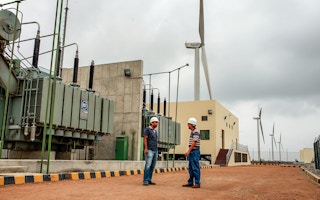Technology is central to the challenge of preventing dangerous climate change. December’s Paris Agreement delivered a strong mandate for countries to ramp up cooperation on technology development and transfer to deal with climate change.
To continue reading, subscribe to Eco‑Business.
There's something for everyone. We offer a range of subscription plans.
- Access our stories and receive our Insights Weekly newsletter with the free EB Member plan.
- Unlock unlimited access to our content and archive with EB Circle.
- Publish your content with EB Premium.
As the 22 April New York signing ceremony for the Paris Agreement draws closer, United Nations bodies have been working on how to turn the Paris conference’s pledge of increased technology cooperation into reality.
Crucially, the Paris technology commitments include but extend beyond renewable energy and energy efficiency. The reference to ‘environmentally sound technologies and know-how’ in the 1992 Climate Convention (which the Paris Agreement has been designed to implement) has shaped initiatives in which ‘technology development and transfer’ is defined broadly.
This has been important for countries facing urgent challenges of adapting to the effects of climate change, such as more intense extreme weather events, rising sea levels and changed crop yields. Climate technology can mean wind and solar, but it can equally mean technologies to adapt fisheries and aquaculture or to address climate change-induced water stress.
Paris commitments on technology transfer and development
The Paris Agreement commits nations to ‘strengthen cooperative action’ on climate technology. It introduces both a ‘long-term vision’ on technology’s contribution to climate resilience and mitigation and a ‘technology framework’ to guide the work of the Climate Convention’s existing Technology Mechanism.
The Agreement puts a new focus on innovation as ‘critical for an effective, long-term global response to climate change’. It commits the Climate Convention’s technology and financial bodies to support R&D and developing countries’ access to technology, ‘in particular for early stages of the technology cycle’.
In contrast to the Paris Agreement, which enters into force when ratified by at least fifty-five Convention parties cumulatively accounting for at least fifty-five percent of global greenhouse gas emissions, the decisions reached at Paris by the Conference of Parties have immediate effect.
These include decisions to strengthen the Convention’s Technology Mechanism, with further work on research, development and demonstration; to begin developing the technology framework at May’s meeting of climate negotiators; to further develop linkages between the Convention’s technology and financial bodies; and to invite the Green Climate Fund to support access to ‘environmentally sound technologies’ in developing countries.
Implementation: keeping the promise of Paris
This is a broad agenda for the UN bodies and national governments tasked with implementation. This month, two key UN committees met to carry that work forward. The UNFCCC’s Technology Mechanism consists of a Technology Executive Committee (TEC) and a Climate Technology Centre and Network.
The TEC’s responsibilities include policy analysis, making recommendations to the Climate Convention’s parties and facilitating cooperation for technology development and transfer.
Meeting in Bonn, Germany, the TEC crafted a three-year work plan that addresses the Paris outcomes, including work on innovation and research, development and demonstration.
The committee also dealt with the ongoing question of how to better coordinate technological and financial cooperation under the Climate Convention, settling on a draft agenda for the workshop on linkages between the UNFCCC’s Financial and Technology Mechanisms which will take place at the next session of UN climate negotiations in May.
The Financial Mechanism includes the Global Environment Facility and the recently operationalized Green Climate Fund. Participants also discussed how technology cooperation could support implementation of Nationally Determined Contributions under the Paris Agreement, with one participant observing that almost all developing countries included technology in their intended Nationally Determined Contributions.
Also part of the Technology Mechanism, the Climate Technology Centre and Network (CTCN) manages a network of public and private institutions that respond to technical assistance requests from a growing number of developing countries, while also providing services to build developing countries’ climate technology capacity.
The pace of requests for technical assistance has accelerated since the CTCN began receiving them in December 2013, with a total of almost one hundred requests submitted by fifty different countries. Significantly, almost twenty percent of requests relate to ‘policy, planning and law’, illustrating the importance of institutional ‘software’ to the uptake of technological ‘hardware’.
During the week following the TEC meeting, the CTCN’s Advisory Board met in Vienna. On the agenda were a host of matters including the CTCN’s linkages with the Green Climate Fund and the CTCN’s role in research, development and demonstration of climate technologies.
Looking to May as climate negotiations resume
With December’s Paris conference having set a positive direction on climate technology, the task ahead is to build on gathering momentum.
Renewable energy capacity has increased by around one third over five years, there was record investment in renewables in 2015, with investment in renewable power capacity more than double the money spent on new coal and gas generation, and renewable power generation costs are falling.
But much more remains to be done, both on renewables and other technologies that enable climate resilience and mitigation.
The COP21 technology outcomes highlight the Paris Agreement’s nature as an iterative process rather than an endpoint in and of itself. The May session is an opportunity for national delegates to make a positive and ambitious start to negotiations on the content of the technology framework.
It is also an opportunity for progress on linkages between the financial and technological institutions of the Climate Convention and, through the technical expert meetings, productive exchanges including the private sector.
The Paris Agreement’s language on R&D and early stage technology, the Green Climate Fund’s commitment to backing ‘cutting edge’ technology and initiatives like Mission Innovation and the Breakthrough Energy Coalition point to an emerging agenda on innovation across both public and private sectors.
Stephen Minas is a research fellow at the Transnational Law Institute, King’s College London. This post was written exclusively for Eco-Business.











